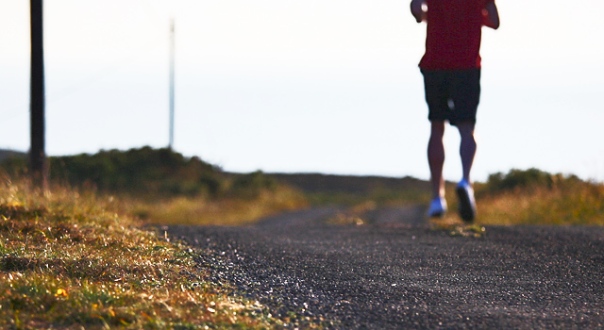http://www.fastcompany.com/1783263/the-creative-brain-on-exercise
Category Archives: Running
From Treadmill to the Road
 When temperatures hit the extremes, cold in the winter and hot in the summer, runners traditionally seek shelter by hitting their treadmills. But while you may be hitting new PR’s inside, you may be shocked to hit walls once back outside.
When temperatures hit the extremes, cold in the winter and hot in the summer, runners traditionally seek shelter by hitting their treadmills. But while you may be hitting new PR’s inside, you may be shocked to hit walls once back outside.
“Mentally, the transition is difficult because your mind expects the body to be able to run like it did on the treadmill,” says Denver Benton, running coach and creator of the Forge Trail Running Series. “However, because running is much more taxing on the road you can’t run as long and it’s more uncomfortable.”
Training for races scheduled in the cool fall months, runners can fool themselves into thinking they are ready to set new PR’s after running for several weeks or months inside on treadmills. Benton, who trains runners of all abilities in Baton Rouge, Louisiana, says he sees runners who are surprised that they were running longer and faster than they ever had before on treadmills during the steamy summer months only to fall flat once back on pavement.
“Getting back out of gym hibernation can be very frustrating at first if you’re not prepared for it,” says Benton. “On the treadmill, the machine maintains a set pace throughout the run but on the road, you constantly have to adjust the pace based on terrain, weather and how you feel.”
Setup for Success
While training on a treadmill during off-season months, runners need to keep in mind several techniques for avoiding muscle atrophy. Benton takes his runners through a series of steps to ensure a smooth transition.
Grounded in Reality
To avoid discouragement and worse yet, injury, runners should be educated on what to expect when transitioning from treadmill to road running. “Setting accurate expectations for yourself is one of the most important aspects of training,” says Benton. “Runners need to know that stepping from treadmill to the street does not equate.”
Start Slow
Benton advises his runners to start with an 8 to 10 week training schedule to ensure they don’t over-do it too early and cause an injury. A schedule can also help runners gain confidence from seeing improving results. In following the schedule, “we would incorporate a short road run into the weekly workouts. Each week we’ll increase the time on the road and decrease the time on the treadmill,” says Benton. “All of the remaining treadmill runs will be on an incline of 1-3. This will force the legs and joints to work harder, lessening the effects of the road.”
Never Stop
The easiest way to avoid the pitfalls of treadmill to road running is to never stop road running. Even if it’s only for 15 to 20 minutes a couple days a week, keep running outside during your extreme season. Also, to simulate road running on your treadmill, increase the incline gradually to work out muscles that would otherwise not get used.
Pace Yourself, Not Stress Yourself
Once back on the road, take 3 or 4 weeks and slow the pace. Benton stresses to his clients to set their pace based on how they feel rather than setting pace from a watch.
“Runners tend to rely too much on technology and not enough on the body,” says Benton. “Your body will tell you everything you need to know if you just listen to it.”
Get to the Core of It
Core work, consisting of a regular regimen of hip, abdomen and lower back exercises, can give your body a head start on recovering from weeks of treadmill running. The muscles used in road running will be stronger from the start and will better adapt when it’s time to hit the pavement again. “A quick 30 minute core workout can make all the difference in how your body responds to the road,” says Benton.
Take it Off Road
The best regimen for getting back to running on the road may be taking it off road. Benton prescribes a trail run every 2 weeks to his clients to add strength and stamina. “Running on trails provides a great change of pace, but also helps to strengthen your ankles, hips and knees,” says Benton. “I like to incorporate a trail run every couple weeks.”

Checklist
- Don’t run exclusively on a treadmill. Make sure at least a third of your runs are outside on pavement even if they are short runs.
- While running on a treadmill, increase the incline gradually to work muscles that would otherwise tend to suffer atrophy.
- Take steps to increase core strength with exercises designed to workout muscles that may get weak from exclusive treadmill running.
- Educate yourself on what to expect for your transition from treadmill to road running. It may take a few weeks and runs to get your speed and stamina back on track.
- Set running pace for a few weeks based on stamina and feeling rather than a watch.
- Incorporate an off-road trail run every two weeks to help strengthen ankles, hips and knees.
Authors
Craig Simmons and Scott Ford
3 Must-Have Health & Fitness Apps For The Busy Business Professional
3 Must-Have Health & Fitness Apps For The Busy Business Professional
BY AMBER MAC
It’s easy to get behind when you’re a busy executive. It’s also easy to get a big behind when you’re a busy executive. Yes, sitting at a desk all day, flying from city to city, and collapsing on the couch as soon as you get home from back-to-back meetings can all contribute to weight gain and a general feeling of unhealthiness. Oh, and let’s not forget the endless vending machine snacking and late work dinners out.
Fortunately, the very technology that is tethering us to our work can also help us to stay in shape. More than 40% of doctors believe that mobile health tech can reduce the number of office visits and more than 80% of doctors currently use smartphone and medical apps in their own practices, according to data released last month from Float Mobile Learning.
With more than 10,000 health care apps on the market distributing an endless amount of free or almost free information, it’s clear that smart working professionals should be in much better shape. After all, the most successful business people are often high achievers, constantly looking for better ways to improve their diets and enhance their exercise routines for more energy at the office. However, with so much time spent focusing on work and so little time to homing in on health, it’s tough to piece together the perfect mobile solution.
To make better food choices and to put physical activity back on top of your to-do list, here are three apps that can ensure you’re ahead on the fitness front.
LoseIt (iOS/Android – FREE)
Most nutritionists and personal trainers will tell you that tracking what you eat and how much you work out is one of the best ways to lose weight and stay healthy. Unfortunately, a paper-based food diary can be a cumbersome method to monitor every snack you have and every step you take. A better answer is LoseIt. This app makes it a cinch to record everything that goes in your mouth, without taking up too much time in your busy day. Just ate a handful of almonds? This mobile download will tell you that 10 of these tasty treats have 69 calories (and it will break down the carbohydrates, fiber, sugars, protein, and more). If you have a weight-loss goal, just enter that number into the app and LoseIt will calculate your daily caloric allowance. The more exercise you do (which you must also track), the more calories the app will “give” you back. If you want to share your LoseIt progress, you can output daily reports (or just keep all your great progress to yourself!).
Fooducate (iOS/Android – FREE)
It’s easy to make bad food decisions when you’re rushing around all day, trying to keep up with a nonstop schedule. Sometimes reaching for that Kashi Protein & Fiber Bar tin your desk might seem like a smart and healthy choice, but you may not know that the Chocolate Almond Toffee variety gets a “D” food grade. Based on the Fooducate app, this product has more than 20% of your daily saturated fat allowance (which, according to information also supplied in this tool, is responsible for bad cholesterol buildup). Instead of making poor food choices, use this app to automatically scan a barcode when you’re shopping for snacks or looking for lunchtime meals or simply do a product search from within the tool. Not only will the app give you the food information you’re searching for, it will also provide healthier recommendations so you can eat better when you’re on the run.
P90X (iPhone, $4.99)
If you’re looking for an intense way to get fit, the P90X exercise routine is getting a lot of mainstream buzz. This new app includes a day-by-day schedule for the popular 90-day home workout program. There are detailed photos and videos to show you how to do each exercise correctly, and a colourful journal to ensure you’re meeting your fitness and diet goals. While this program can be done at home or on the road, there is a significant time commitment of an hour per workout. For business professionals looking at something a little less intense, on the other end of the spectrum is the newly updated Lastics Office Stretch app (iOS/Android – 99 cents). This digital download, which also provides step-by-step videos, is ideal for anyone looking for two- to four-minute stretches that are easily done at the office. This is the perfect mobile companion for anyone who needs a short break from staring at a computer screen or who is stuck on conference calls all day.
[Image: Flickr user Séan Venn]
2012 Forge Trail Series – Louisiana Trail Running State Championships
Sign up Today for the 2012 Forge Trail Series, The official Louisiana Trail Running State Championship Series. Whether you’re a weekend warrior or an Olympic hopeful, our races are sure to leave you feeling completely spent and inspired to do it all over again. CLICK HERE to register for all of the races and save yourself some cheese.



